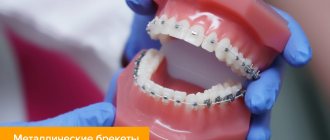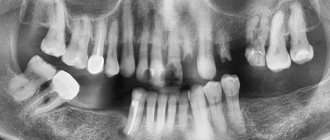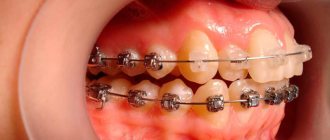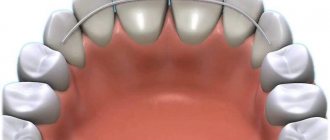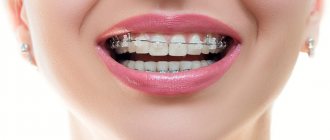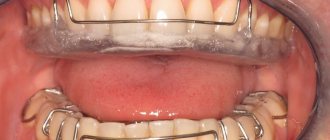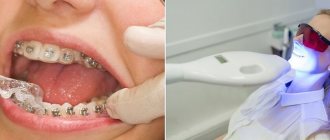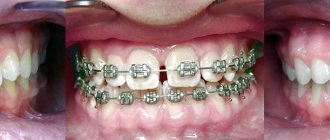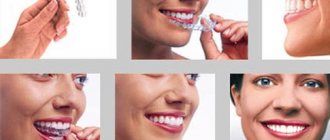Braces are structures used in orthodontics that are necessary to correct malocclusion and uneven teeth. They are made from different materials; the modern method is to install ceramic braces, the pros and cons of which are described below. Indications for this type of treatment include the following conditions:
- malocclusion - in some cases, this problem may not bother a person and may not be visually manifested, but with more severe damage, facial distortions, speech impairment, and breathing and swallowing disorders may be observed;
- dense placement of teeth in the dentition - causes not only an aesthetic defect, but can also lead to the accumulation of pathogens in the oral cavity, abrasion of enamel, caries, damage to the mucous membrane and soft tissues;
- disproportionate development of the upper and lower jaws - the appearance of the dentition is distorted, which is noticeable during laughter, conversations, and the chewing process is also disrupted;
- dystopic arrangement of one or more teeth - implies rotation, advancement forward or backward;
- low density of teeth due to intrauterine pathology of organs and systems, hereditary predisposition.
It is recommended to install braces from the age of eleven to twelve, when the dentition has formed; until this moment, it is not advisable to use such methods on the development of teeth. There is no upper age limit. However, it should be noted that after thirty years the process of restoring a correct and even dentition takes longer - this is due to age-related changes, a slowdown in metabolism and regenerative properties.
What kind of design is this?
This is a modern device that straightens teeth and allows a person to feel confident due to the fact that they are practically invisible against the background of the enamel.
These systems are matte and their color can be matched to the shade of a person's enamel. Modern orthodontics is developing newer and more elegant designs that reduce metal and minimize external aesthetic inconveniences.
In terms of efficiency, they are not inferior to, and even superior to, conventional braces systems.
pros
Undoubtedly, ceramic braces are leaders in aesthetics during orthodontic treatment. The shade of the plates is selected according to the Vita scale, based on the color of the patient’s tooth enamel. Therefore, the plates are not noticeable even at close range.
Despite the fragility of the material, ceramic structures are able to withstand full chewing load. No chips or cracks.
Ceramics has the property of maintaining its original appearance throughout the entire period of wear. The material is resistant to pigmentation and does not darken over time. Therefore, ceramics in dentistry are used to make crowns and veneers.
Ceramics are also safe and environmentally friendly. Patients with high sensitivity and a tendency to allergies can safely wear ceramic braces. But it will be necessary to take into account the presence of metal elements in the structure.
The adaptation period after installing braces is minimal - less than a week. The plates have a rounded shape, without protruding sharp corners. This prevents injury to the oral mucosa.
For patients whose priority is aesthetics, ceramic braces are the most affordable. Compared with sapphire systems, or lingual structures for installation on the inside of the dentition.
How are they arranged?
Such systems are designed to correct the position of teeth as quickly as possible, without pain and inconvenience , and with minimal aesthetic problems.
Ceramic braces are permanent structures. They consist of the following elements:
- clasps – their number is designed to be attached to each tooth, they are attached with special dental glue;
- arches are connections between clasps that are tightened for alignment with special devices; most often they are made of a material with memory in order to put an unevenly grown tooth in place.
The clasps are made of ceramic, and the arches are made of metal. Orthodontists can offer a system with a white arch , then such braces are practically invisible on the teeth.
The best ceramic braces
Good reviews of ceramic and metal braces from the following companies:
- Forstadent (Germany);
- Dentaurum (Germany);
- 3M Unitek (USA);
- Dentsply GAC (USA);
- ORMCO (USA).
Forstadent
TruKlear® / Quick Clea braces are self-ligating products made entirely of ceramic. They can only be seen from a very close distance. They are securely attached to the tooth, easily removed, without chipping or damaging the enamel.
The range also includes QuicKlear/Quick Klea - ceramics with a metal clip. To prevent the latch from being noticeable, it was given a matte surface. The locks are flat, which speeds up the addiction.
Dentaurum
Dentaurum offers several options for metal and ceramic bracket systems:
- Discovery – ceramic transparent braces, almost invisible. Thanks to the anatomical basis, they adhere well to the tooth. The staples are designed using a unique technology and are almost invisible. You can choose models with colored guides.
- Dinamique c are self-ligating structures, the color of which is perfectly matched to the shade of the enamel. The clip is rhodium plated with a premium chrome cobalt alloy that protects the clip from scratches and damage.
- Fascination 2 are transparent models with a Sabbagh spring that are ideal for treating the problem of crowded teeth.
- Jewels Ceramic Brackets - colored ceramics, interesting for children and teenagers. Braces are made only to individual order.
3M Unitek
3M Unitek offers the Clarity APC Series braces. They are based on a light-curing adhesive, which simplifies the fixation procedure. Flash-Free technology protects the enamel from oxidative processes that can occur when food accumulates along the edges of the product.
GAC
Mystique from GAC are made of reinforced ceramic (added silica). It makes the product resistant to breakage. The grooves are covered with a silicate film, which reduces the friction force of the metal arch and improves the pressure on the teeth.
Another interesting option is n-Ovation (C). These are non-ligature ceramic products with a metal groove and clip that provide constant and uniform pressure on the crowns. They are well fixed to the crowns, do not come off during use, and are comfortable to wear.
ORMCO
Damon-3 non-ligature metal and ceramic braces are very small and unnoticeable. The ceramic base and metal groove provide low friction, which promotes rapid teeth straightening.
Kinds
Such constructions are divided into two types: ligature and non-ligature. Their installation is carried out according to the doctor’s indications and the patient’s wishes. They, like other leveling structures, have their advantages and disadvantages.
Ligature
Ligature ceramic braces do not contain metal elements other than the arch itself . Locks made of ceramic have a groove where the arch is attached.
There is also an elastic ring in the groove; it holds the arc. The ring is transparent and does not stand out against the background of the enamel . It was this element (ligature) that became the reason for the name of the design.
The advantages of ceramic ligature braces systems include:
- Colored ligatures are used, which is exciting and interesting for children and teenagers.
- Ligatures are elastic, which minimizes discomfort during the teeth straightening process.
- Effective.
Main disadvantages:
- Elastic elements may lose their elastic properties over time, in which case they will have to be replaced.
- Compared to non-ligated braces, they take longer to straighten teeth.
- The metal arc is fixed motionless, this increases friction and causes discomfort during use.
- Nicotine, coffee, strong teas and other food dyes can stain ceramics, which then releases ligatures onto the enamel.
- It is difficult to care for this structure.
- Ceramic ligature systems are more expensive and require monthly visits to the doctor.
Unligated
These structures can be adjusted themselves; they are also called self-ligating. They allow you to reduce the time required for the leveling process to a minimum.
Their peculiarity is that the system contains sliding clamps, which facilitates quick replacement of the arc. With such a replacement, the patient does not feel pain or any discomfort .
Here the arc is not blocked, but is fixed. It is comfortable and painless for the patient.
Such brace systems have their advantages:
- Injuries to the mucous membranes of the oral cavity occur very rarely; such ceramic structures operate with minimal pressure.
- Visiting a doctor is limited to once every 2-3 months.
- The friction force in this treatment is reduced, and the teeth straightening process occurs faster.
- Ceramics do not react chemically with saliva, so they are safe for health.
- When installing this design, oral care is simplified.
- Adaptation to the system occurs quickly due to the lack of bulkiness.
- Each tooth moves individually, falling into place.
- There are no contraindications for this treatment; even periodontitis is not an obstacle to straightening teeth.
- Installation and removal of ceramic non-ligature braces is quick and painless.
This system has no disadvantages; it is the latest development in orthodontics. The ceramic brace system is lightweight, which makes it much easier to get used to.
How are they different from metal ones?
Metal braces have the least aesthetics, although manufacturers have worked on this factor. Nowadays locks are produced not only in rectangular shapes, but also in the shapes of hearts, leaves and stars. To achieve an even greater cosmetic effect, ligatures are made in color, which is mainly liked by children and teenagers. But something else is important - metal braces are able to cope with complex orthodontic problems in a fairly short time.
Ceramic systems are aesthetically more attractive and more comfortable due to the rounded shape of the locks. In addition, ceramics are inert, so they do not cause discomfort in the oral cavity, for example, in case of metal intolerance.
Popular manufacturers
There are several companies specializing in the manufacture of ceramic braces systems. The main components of the designs are the same, but they also have their differences.
Clarity
The company produces aesthetic non-ligation braces systems; they are transparent, so they are practically invisible on the teeth . The design’s clasps are anatomical, which allows them to fit as closely as possible to the surface of the tooth.
They have a microcrystalline surface at the base and an anatomical contour of the base. Each brace is individually packaged and marked.
Damon
These designs differ in the structure of the braces. The company produces non-ligature systems; wire or rubber ligatures are not needed for their fastening.
photo: Damon Clear combined braces
The arc is attached to the locks themselves, this allows you to keep its mobility under control. The metal arch in braces is closed with the help of special caps that hold it. This design allows the use of softer arcs.
Reflections
Systems from this company are predominantly ligature. Reflections ceramic systems are composed of polycrystalline aluminum oxide. This material is durable and almost transparent. This allows us to characterize the systems from this company as aesthetic.
Usually ligatures stain over time, but Reflections braces do not. Ceramics are resistant to food dyes, as well as chemical and temperature influences. Such systems do not cause allergic reactions.
In-ovation
The newest non-ligature systems are lingual (which are installed on the back of the teeth) and vestibular. These are aesthetic systems; they do not injure the mucous membrane.
In such designs, rubber bands and wires are not used; there is a special mechanism for controlling the arc. Systems from this company allow you to track and control the movement of each tooth.
Models Clarity and Clarity SL from 3M Unitek (USA)
As for the Clarity model, this is a traditional ligature system, where the arch is fixed using rubber bands. But the Clarity SL model is self-ligating ceramic braces (but if indicated and as necessary, you can selectively ligate the arch with elastic bands).
The photo shows the Clarity system
In both samples, the plates themselves have an anatomical contour, a microcrystalline surface and rounded edges. In addition, they are reinforced with an open metal groove (lock) made of stainless steel. All this allows the system to be very durable, ensures the reliability of its fixation on the teeth, makes the process of adaptation and subsequent use comfortable, and makes the treatment as effective as possible for the patient. These design features also reduce the risk of mucosal injury to zero and simplify daily hygiene care.
The manufacturer positions its devices as one of the fastest to install, eliminating time-consuming steps in the orthodontist’s office. The fact is that each plate is already treated with an adhesive composition. In addition, when in contact with the enamel, the adhesive acquires a pink color, which allows the doctor to accurately determine its location and carefully remove excess if necessary.
The photo shows teeth before and after treatment
When choosing these aesthetic models, the cost of correcting the bite on one jaw will cost you approximately 110-120 thousand rubles.
Flaws
Ceramic braces systems have their advantages and disadvantages. Their main disadvantages include:
- High cost - not every person can afford to install such systems. They are made of high-strength quality material, which increases their cost. Also, the price depends on the type of structure.
- The treatment period is slightly longer compared to metal braces. This occurs due to the fact that ceramics puts less pressure on the teeth, which slightly prolongs the period of their alignment.
- If ceramic braces fit too tightly to the enamel, this can lead to changes in its color, composition and destruction. The doctor regulates the tightness of such systems.
The essence of corrective therapy using braces
The principle of the corrective effect of orthodontic devices is the ability of teeth to move in a given direction under the influence of mechanical pressure. Braces systems are devices that create adjustable directional force. With their help, orthodontists correct congenital and acquired bite defects and correct abnormal tooth growth.
Braces are an orthodontic structure that consists of miniature bracket plates, fixed with an adhesive composition on the tooth enamel, and a power arch attached to these plates. The arc is bent taking into account the characteristics of the clinical case of a particular patient. The material of this power element has so-called “shape memory”. This means that the arc tends to straighten. Thus, she pulls the bracket plates behind her, moving the teeth in the desired direction.
The described process is accompanied by remodeling of the bone tissue in which the tooth is held: resorption in the direction of movement and the simultaneous formation of new tissue in the opposite direction. This prevents the tooth element from returning to its original location.
Note: treatment of occlusion pathologies using braces can only begin when a permanent dentition has been formed, i.e. after 12–14 years.
Installation Features
Ceramic braces are installed on the outside of the teeth using special dental glue. This glue is selected for ceramics so as not to change its shade on the teeth. Locks are glued to each tooth separately.
Depending on the type of system, the arc is fixed. The installation process is not painful and takes from 20 to 40 minutes. But before installation, the patient must go through a preparatory stage with the making of impressions and filling of diseased teeth.
Experience ceramic from TOMY Inc (Japan)
Since 2012, the official distributor of orthodontic products manufactured by the Japanese company TOMY Inc is the German corporation GC Orthodontics.
The photo shows Experience ceramic braces
What are Experience systems? A whole line of products is produced under this name, but here we will only talk about the aesthetic ceramic models Experience ceramic and Experience ceramic mini. Both bracket systems operate on the principle of self-ligation, that is, the power arc is snapped into them using special locks. At the same time, the clips of the clasps are coated with a thin layer of rhodium, which allows them to completely merge with the body of the bracket and improves the aesthetics of these devices.
Read the article on the topic: TOP 20 dentists where you can correct your bite.
Braces marked mini are compact and provide increased comfort for the patient. They are very durable and impact resistant, just like the Experience ceramic model.
The cost of bite correction with these devices is about 85 thousand rubles per jaw.
Notice
: Undefined variable: post_id in
/home/c/ch75405/public_html/wp-content/themes/UltraSmile/single-item.php
on line
45 Notice
: Undefined variable: full in
/home/c/ch75405/public_html/wp-content /themes/UltraSmile/single-item.php
on line
46
Rate this article:
( 2 ratings, average: 5.00 out of 5)
braces
- According to the official website of the manufacturer in Russia: dentsplysirona.com/ru
- According to the manufacturer's official website: americanortho.com
Expert “Today, orthodontists have a large number of models of ceramic braces from different manufacturers. They all look decent, but the choice should depend not only on individual preferences and financial capabilities, but also on the clinical situation. For example, not all ceramic models are suitable for correcting complex malocclusions. Therefore, it is better to first undergo a thorough diagnosis in order to understand what you are dealing with, and then consider different options.” Orthodontist Vagapov Zakir Irkinovich
Consulting specialist
Chorny Stanislav Vladimirovich
Doctor rating: 9.8 out of 10 (4) Specialization: Orthopedist Experience: 19 years
Prescriptions and contraindications
Treatment with braces is prescribed from the age of 12 years, when all the teeth have changed and are ready for growth correction.
People who have anomalies in the growth of individual teeth and dentition , who want to improve the aesthetics of their face and profile, and who have unerupted teeth, need to wear braces.
Systems are also installed in preparation for prosthetics and corpus movement of teeth.
Contraindications to treatment with ceramic braces systems are:
- Enamel damage.
- Caries.
- A large number of fillings, crowns.
- Lack of proper nutrition skills (excessive consumption of sweets).
- Mental, immune, severe general somatic diseases.
- Allergy to materials of the brace system.
Reflections from Ortho Technology (USA)
This ligature model is made of pure translucent polycrystalline aluminum oxide. Among the main advantages, the manufacturer highlights the following: excellent appearance, increased strength, reliable fixation and absence of complications during removal, resistance to chips and breakages, impermeability to dyes.
The photo shows teeth before and after treatment with Reflections braces.
Cost – from 85 thousand rubles for installation on one jaw.
Adaptation
Getting used to braces varies from person to person.
For some, this process is painful and takes a lot of time, while others note that adaptation was quick and unnoticed.
But on average, the process of getting used to ceramic systems is accompanied by pain of varying intensity in the gums and teeth.
Sometimes the pronunciation of words and the process of chewing food suffer. If a person is determined to achieve a beautiful smile as a result of treatment, getting used to it will take a little time and effort.
Orthodontic treatment. Why choose us
The success of treating orthodontic problems and the choice of braces for correction directly depend on the following factors:
- the complexity of the patient’s condition and the degree of neglect of the problem;
- patient's aesthetic expectations;
- the cost of treatment and the orthodontic installation itself.
In our clinic, doctors take into account all these factors and select the best solution for the patient, taking into account his individual parameters, wishes and financial capabilities.
The benefits of using our services also include:
- We work exclusively with high-quality and reliable brace systems, which guarantees the results expected by the client in the shortest possible time.
- The appointment is conducted by an orthodontist of the highest category, Khatib Massoud Zidan, whose experience and qualifications allow him to work with various types of systems with turnkey installation.
- Service at affordable prices, without unreasonably increasing costs and prescribing unreasonable procedures.
Our clinic practices an individual approach to service. Each visitor receives qualified assistance without spending unnecessary moral and financial resources.
Care
The brace system makes oral care difficult. Therefore, you need to remember the care rules when installing ceramic structures to straighten your teeth.
- The toothbrush should have bristles with different directions. This will help clean hard-to-reach areas and the surface of the braces. The hardness of the brush should be medium.
- It is important to purchase small brushes. They are needed to clean the enamel under the arches and at the place where the clasps are attached.
- Dental floss can help clean out food debris well.
- You can use mouth rinses after meals to avoid premature darkening or plaque clogging of ceramic braces.
- Regular consultations with a dentist will help not only to properly align your teeth, but also to professionally clean the enamel surface.
Caring for a ceramic bracket system
Hygienic care of braces and teeth during treatment is quite difficult. Therefore, the patient must be prepared to comply with the following rules:
- clean the oral cavity and equipment using V-shaped orthodontic brushes, special brushes, floss, and irrigator;
- Perform hygiene procedures at least 2 times a day, and after eating, rinse your mouth thoroughly. Once every 3-4 months you should resort to professional cleaning in the clinic;
- adhere to a special diet: foods and drinks should not contain strong coloring pigments. You should not eat very hot or cold food, as this contributes to the formation of microcracks in the braces;
- refrain from smoking;
- do not eat sticky substances (for example, toffee, dried apricots, etc.), do not chew nuts.
Comparison of different systems
To understand which braces are better and how they differ, let's look at the following table.
| Types of braces systems: | Ceramic | Sapphire | Metal |
| Anomaly complexity | The aesthetic system copes with minor anomalies. | The aesthetic system copes with minor anomalies. | Coping with any anomalies. |
| Duration of treatment | Longer in terms of teeth straightening, 2-3 months longer to wear than metal ones. | The treatment period is not inferior to metal ones. | Fast in treatment due to a firmly controlled arc. |
| Aesthetics | Ceramics are matched to the color of the enamel. | Transparent, white-coated arcs, almost invisible when smiling and talking. | Not aesthetically pleasing, clearly visible on the teeth. |
| Price | Average in cost. | The most expensive. | Available for all patients. |
Pros and cons of ceramic braces
Let's look at the features of such designs and compare them with other options.
Pros of ceramic braces
The main advantage of the ceramic model in comparison with other types of braces is a beautiful smile. The white color is almost indistinguishable from tooth enamel and does not fade or stain over time. Ceramic coating is not affected by time or coloring products. This means that braces do not attract undue attention and will not cause complexes in teenagers.
Other benefits:
- Lungs . The body quickly adapts to foreign objects in the mouth, which means discomfort will disappear faster.
- They don’t emit toxins – you don’t have to worry about getting poisoned by dangerous substances.
- Hypoallergenic (all-ceramic designs) - ideal for people with allergies to metal.
- Comfortable to wear - do not irritate the oral mucosa, do not injure it due to their rounded shape.
- Easily removed without leaving stains on the enamel. This means that the teeth do not require additional treatment.
The most important advantage of ceramics is that such braces are almost invisible when you smile.
Cons of ceramic braces
Ceramic systems are inferior to metal ones in terms of treatment speed. If steel products are installed for a year, ceramic products - from 2 to 3 years. For a particularly long time, you need to wear non-ligature products, which have a gentler effect and move the crowns. At the same time, you must not forget to regularly visit the dentist once every 1-3 months, depending on the fastening system.
Other disadvantages of ceramic braces:
- Strength. Do you play contact sports (boxing, wrestling, basketball, football, etc.)? Ceramic braces are not for you. If you get a strong blow to the jaw, they may crack. This point must be taken into account when choosing braces for children. Better put metal products. If you are allergic to nickel, our clinic specialists will select a hypoallergenic system, tell you in more detail about metal and ceramic braces, what the difference is between them and how to avoid an allergic reaction.
- The installation method is only vestibular, that is, on the outer part of the crown. Metal devices can be installed from the inside of the crown (lingual structures).
- Cost – The cost of installing ceramic braces is high. Only sapphire models are more expensive.
- Not universal - in very severe cases, it is better to give preference to metal braces.
Is there an alternative
In addition to white ceramics, braces are made of metal, plastic, and artificial sapphire. The main difference between metal braces and ceramic braces is that the lock is not noticeable. Plastic breaks quickly and stains, but is also cheaper. If we compare sapphire and ceramic braces, the difference is that the first option is more expensive, fragile, and the clasps are painted.
What other differences need to be taken into account when choosing ceramic bracket systems can be found in the table:
| Characteristic | Ceramic braces | Metal models | Sapphire products | Plastic systems |
| Aesthetic appearance | High | Short | Super | High |
| Strength | High for the ligature version, medium for models with a clip | Super | Average | Low (prone to breakage) |
| Duration of treatment (depends on the complexity of the case, the age of the patient) | 1-3 years, depends on the type of fastening | 1 year | 1-3 years | 1-3 years |
| Changing bracket color | No | No | Yes | Yes |
| Hypoallergenic | + | — | + | + (special biocompatible material is used |
| Efficiency in cases of serious malocclusion pathologies | — | + | — | — |
| Frequency of dental visits | every 1-3 months (depending on mounting system) | once every 2-4 weeks | once every 1-3 months. | Often |
| Average price without installation (RUB) | 80-150 thousand | 35-75 thousand | 100-200 thousand | 35-45 thousand |
